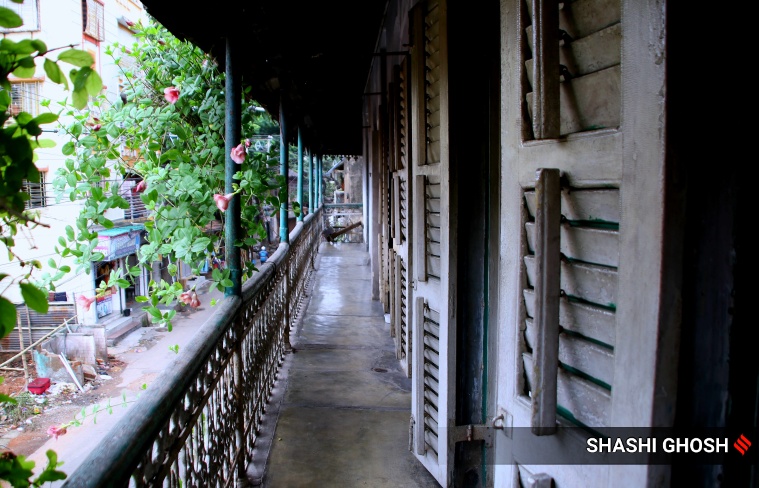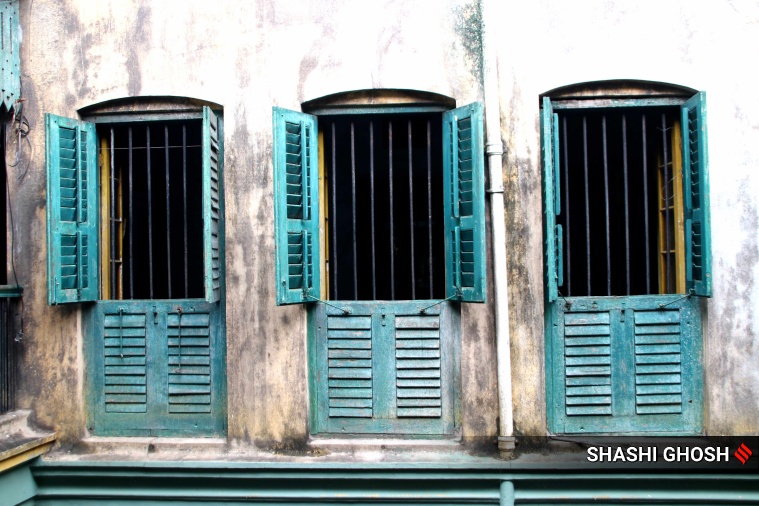Barrister Babur Bari houses many memories but it refuses to be another Kolkata memory. It stands in a part of the city that seems to be waiting for Instagram to happen to it. Beautifully proportioned, slatted-windowed houses juxtaposed against newly-constructed tiles and tinted glass monstrosities, sleepy mudikhanas (grocery) stores that are fighting a losing battle against two-minute delivery apps.
Stories that can be summed up in an Instagram reel with an Ali Sethi song. Or maybe not.
Four women—Nandita Basu, 79, her only daughter Krishnakali, the young caretaker Moitrei Das, and the cook Jhorna Das—are safeguarding not only a beautiful house in the heart of Kolkata, but are also preserving a way of life.
Of courtyards and red floors
Subscriber Only Stories
In 1855, when businessman Chandi Basu, Nandita’s great-great father-in-law, decided to build a house in Beleghata, this bustling north Kolkata neighbourhood was little more than wilderness.
Four women—Nandita Basu, 79, her only daughter Krishnakali, the young caretaker Moitrei Das, and the cook Jhorna Das—are safeguarding not only a beautiful house in the heart of Kolkata, but are also preserving a way of life.
But Chandi Basu, who was in process of corporatising the fisheries business in India, needed to settle near what is now called the East Kolkata Wetlands, a complex network of natural and man-made wetlands at the eastern fringes of the city. That’s where his business was. “Even when I came to this house as a daughter-in-law in 1965, our fishery business was booming. It was during the CPM era, the business slowly closed down,” says Nandita.
The house itself lives up to its name. Barrister Babur Bari or the residence of the barrister is a stately and compact structure that is deceptively large. Half a century ago, Barrister Basu, Nandita’s father-in-law, practised from a cavernous office on the ground floor of the house. His fame led to the naming of the house.
The entrance leads to a modest thakurdalan (courtyard) with pillars and verandahs reflecting the influences of European architecture. An alcove leads to another, more private, courtyard. The red oxide flooring and the restrained sensibilities of the outer courtyard make way for cobbled floors and the turquoise blue of the inner courtyard. It’s a definite shift in mood and sensibilities.
‘An institution’
Advertisement
This quirky house was known for organising one of Kolkata’s most famous Durga Puja in the late 1800s. “I have heard Netaji Subhas Chandra Bose was a regular visitor here,” says Nandita.
 Half a century ago, Barrister Basu, Nandita’s father-in-law, practised from a cavernous office on the ground floor of the house.
Half a century ago, Barrister Basu, Nandita’s father-in-law, practised from a cavernous office on the ground floor of the house.
The speciality of the Basu family puja was that it was organised by the womenfolk of the family. “Unlike other such family pujas, where men of the family play an important role in organising the puja, our puja is mostly a women’s affair,” says Krishnakali, 45, who is settled in Gurgaon now.
According to the family lore, during the communal riots of 1946-1947, many Muslims of the area sought shelter in the house during pujas using Hindu names. It was a decision taken by the women of the house. “My mother, who is a renowned paediatrician of the area, embodies that strength,” says Krishnakali.
Advertisement
That’s probably why even during the coronavirus pandemic, when the whole city was shunted into silence, the women of the Basu family, organised a small puja at the house, ensuring that the century-old tradition was not broken.
Nandita, who presides over the sprawling building with almost stoical resolve, says the 200-year-old structure is held together by the “determination” of the women of the house. “I have only my daughter, Jhorna, and Moitrei to fall back on. Ever since my husband passed away in 2017, we have been hounded by promoters. They want to raze the house down,” she says.
 The entrance leads to a modest thakurdalan (courtyard) with pillars and verandahs reflecting the influences of European architecture.
The entrance leads to a modest thakurdalan (courtyard) with pillars and verandahs reflecting the influences of European architecture.
Jhorna, 62, who has been working with the Basus for around two decades, feels the house is an “institution” in the locality. “Every single family in this area has some emotional connection with this house. They have memories connected to it,” she says.
Moitrei, 24, echoes the sentiment. “I have grown up in this locality. We all spent pujas at Barrister Babur Bari. I bring my daughter here to play. This house is more than just a building for us,” says Das.
Preserving a ‘white elephant’
The fact that the co-owners of the house, the family of Nandita’s husband’s brother, are not very keen on keeping it, doesn’t make things easy. “We have been close to closing a deal a number of times with promoters. But I have backed out at the last moment every time. I will go into depression if the house is razed down,” says Krishnakali.
Advertisement
Maintaining a house like this takes money and the two years of the pandemic have added to the woes of the Basu women. “We have used up all our savings. Every other day, there is some expenditure or the other. The ceiling has a leak that needs to be fixed, the walls need repainting. This is like a white elephant,” says Krishnakali. “Recently, the other old house next to ours was razed down. The owners couldn’t just maintain it. People don’t have any money and promoters are taking advantage of that,” she adds.
 The red oxide flooring and the restrained sensibilities of the outer courtyard make way for cobbled floors and the turquoise blue of the inner courtyard. It’s a definite shift in mood and sensibilities.
The red oxide flooring and the restrained sensibilities of the outer courtyard make way for cobbled floors and the turquoise blue of the inner courtyard. It’s a definite shift in mood and sensibilities.
The pandemic that has taken away so much from so many has, however, gifted Nandita a steely resolve to save the house she calls home. “The past two years were difficult, but I decided that I won’t let the house fall prey to the greed of promoters now,” she says.
Advertisement
Slowly, doors opened. “I opened an Instagram page and a friend suggested that maybe we can rent out the house for film shoots,” says Krishnakali. A web series shoot led to a film shoot and now Barrister Babur Bari has a healthy number of bookings.
But will that be enough to save the house? “We are trying to talk to experts and see if we can get heritage status. I am also ready to collaborate with people who would want to convert this place into a homestay. We need to convince my cousin that this house is a commercially viable proposition and we are working towards that. This house wants to survive,” sums up Krishnakali.
Source: https://indianexpress.com/article/cities/kolkata/how-these-women-are-fighting-to-save-a-200-year-old-kolkata-house-8180669/


